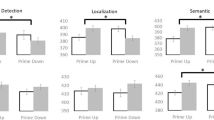Abstract
Interacting with the world around us involves dealing with constant information input. Thus, humans must selectively filter and focus attention on relevant aspects for the current situation. The current study investigates orientations of attention after words that do not convey spatial information in their meaning (e.g. cloud, shoe). The current study minimizes both the linguistic demands by simply presenting task-irrelevant words and the visual processing demands by implementing a simple target detection task. According to automatic response biases in the motor domain (Lachmair et al. 2011), we hypothesized that words such as cloud produce attention shifts in the direction of the typical location of the word’s referent in the world (e.g. cloud up in the sky). Indeed, target detection was facilitated if target location matched the typical location of the word’s referent. These findings are strong evidence for the important role of space during language processing, showing that vertical attention is modulated even by task-irrelevant verbal cues.


Similar content being viewed by others
References
Barsalou LW (1999) Perceptions of perceptual symbols. Behav Brain Sci 22:637–660
Bub DN, Masson MEJ, Cree GS (2008) Evocation of functional and volumetric gestural knowledge by objects and words. Cognition 106:27–58
Chasteen AL, Burdzy DC, Pratt J (2010) Thinking of god moves attention. Neuropsychologia 48:627–630
Dudschig C, Lachmair M, de la Vega I, De Filippis M, Kaup B (2012) Do task-irrelevant direction-associated motion verbs affect action planning? Evidence from a Stroop paradigm. Mem Cogn. doi: 10.3758/s13421-012-0201-9
Dudschig C, Jentzsch I (2008) Locus of response slowing resulting from alternation-based interference. Psychophysiology 45:751–758
Estes Z, Verges M, Barsalou LW (2008) Head up, foot down: object words orient attention to the object’s typical location. Psychol Sci 19:93–97
Fischer MH, Castel AD, Dodd DD, Pratt J (2003) Perceiving numbers causes spatial shifts of attention. Nat Neurosci 6:555–556
Glenberg AM, Kaschak MP (2002) Grounding language in action. Psychon Bull Rev 9:558–565
Hauk O, Johnsrude I, Pulvermüller F (2004) Somatotopic representation of action words in human motor and premotor cortex. Neuron 41:303–307
Hommel B, Pratt J, Colzato L, Godijn R (2001) Symbolic control of visual attention. Psychol Sci 12:360–365
Johnston JC, McCann RS, Remington RW (1995) Chronometric evidence for two types of attention. Psychol Sci 6:365–369
Lachmair M, Dudschig C, DeFilippis M, de la Vega I, Kaup B (2011) Root versus roof: automatic activation of location information during word processing. Psychon Bull Rev 18:1180–1188
Loftus GR, Masson MEJ (1994) Using confidence intervals in within-subject designs. Psychon Bull Rev 1:476–490
Todd Maddox W (2001) Separating perceptual processes from decisional processes in identification and categorization. Percept Psychophys 63:1183–1200
Zwaan RA, Yaxley RH (2003) Spatial iconicity affects semantic relatedness judgements. Psychon Bull Rev 10:954–958
Acknowledgments
This project was supported by a Margarete-von-Wrangell Fellowship awarded to Carolin Dudschig (European Social Fund and the Ministry Of Science, Research and the Arts Baden-Württemberg) and by the SFB833/B4 project of Barbara Kaup (German Research Foundation).
Conflict of interest
This supplement was not sponsored by outside commercial interests. It was funded entirely by ECONA, Via dei Marsi, 78, 00185 Roma, Italy.
Author information
Authors and Affiliations
Corresponding author
Rights and permissions
About this article
Cite this article
Dudschig, C., Lachmair, M., de la Vega, I. et al. From top to bottom: spatial shifts of attention caused by linguistic stimuli. Cogn Process 13 (Suppl 1), 151–154 (2012). https://doi.org/10.1007/s10339-012-0480-x
Published:
Issue Date:
DOI: https://doi.org/10.1007/s10339-012-0480-x




